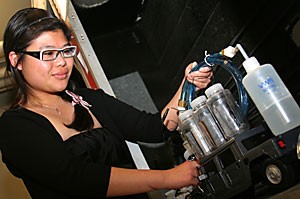Five chemical engineering students put in as much effort as their strenuous school schedules would allow this semester to build a chemically powered model car.
Trying to perfect several chemical equations in a week’s time proved too much, however, and the team was unable to have a car ready for the March 23 American Institute of Chemical Engineering (AIChE) Chem-E-Car competition held at Arizona State University.
“”We gave it our best shot,”” said Laura-Ann Chin, a chemical engineering freshman. “”We were trying to cram a year’s worth of work into a month or so.””
The team worked more than three hours a day during the week leading up to the competition.
Their initial blueprints for the car included timing and mechanical devices – both prohibited in the 15-page list of AIChE Chem-E-Car competition rules.
The students eventually decided to use a combination of hydrogen peroxide and catalase to produce a gas that would run through a tube filled with a conductive solution. The conductive fluid would then close a circuit that was connected to the battery and motor.
The students manufactured every part of the car themselves with the exception of the circuit board and body of the car, which was based off a remote-control car they bought from a toy store.
Unfortunately, the system was unable to power the car for more than “”one-second bursts,””said Tristan Day, a chemical engineering sophomore.
Chin said the battery was one of the main problems with the project.
“”Our battery was reading 0.1 volts instead of six volts,”” she said.
Additionally, sulfuric acid decomposed the glue that kept the battery plates in place, transforming the battery into a simple conductor, Day said.
The second major problem was the team’s inability to create a constant flow in the tube that held the conductive solution.
“”We shouldn’t have had the circuit connect directly to the main motor; it should’ve instead powered another switch,”” Day said. “”We needed another few weeks.””
Wayne Wesolowski, a UA chemistry lecturer who gave some last-minute advice to the team, said, “”Research is 99 percent failure. That’s routine for research.””
The students worked on the car almost entirely by themselves, with little help from UA professors and mechanical specialists.
“”The only thing I really helped them with was what materials to use,”” said Lorenzo Lujan, the chemical environmental department staff engineer. “”I’m just impressed with the students taking the time to build this on their own.””
Said Cayci Johns, a chemical engineering junior: “”I didn’t know we had the (regional championships) coming up this soon, I was intending on having the entirety of this semester and the summer to work on (the project).””
Johns estimated the car cost under $100, which will be funded by the chemical engineering department and donations from local companies. Students were allowed to use up to $2,000 under competition rules.
Had the students made it to the competition, they would have received a set amount of water their car would have to carry, varying between zero and 500 milliliters. The car also must travel a distance determined at the competition ranging from 50 to 100 feet.
The team whose car travels the closest to the finish line without going over wins a $2,000 cash prize. Additionally, those who finish in first through third place will be eligible to compete in the Oct. 27 AIChE Chem-E-Car Competition National Championships in San Francisco.
This is the second year Arizona has attempted to create a car for the competition.
“”Last year’s team was made up of seniors who never got their project off the ground,”” Johns said. “”They left us with just a little scrap metal and nothing really to work with.””
Johns kept track of the 2006 team and decided to assist the project this year to see if she could help create a car that would be ready for competition.
This year’s team was made up of Chin, Day, Johns, and sophomores Mark Sholin and Chandra Khatri. They began working on the project in mid-January.
“”It would have been nice if we had some other fields of engineers help us out,”” Day said.
All of the current members plan on continuing their design and having it ready for next year’s competition.
The regional competition consisted of 30 other teams from colleges in the Rocky Mountain region.
Despite the setbacks, Chin said she had a great time working on the car and applying the material she learned from the classroom to the real world.
“”School’s not all about books,”” she said.









